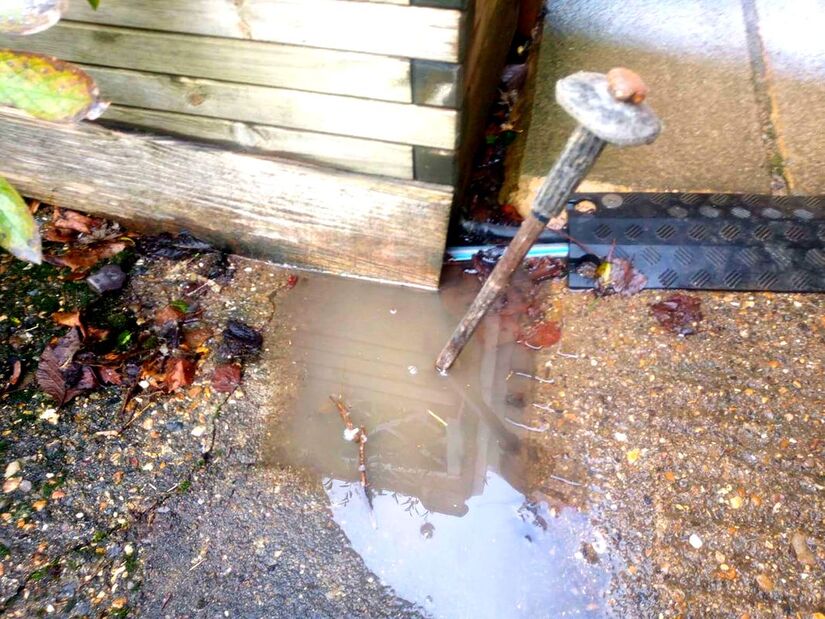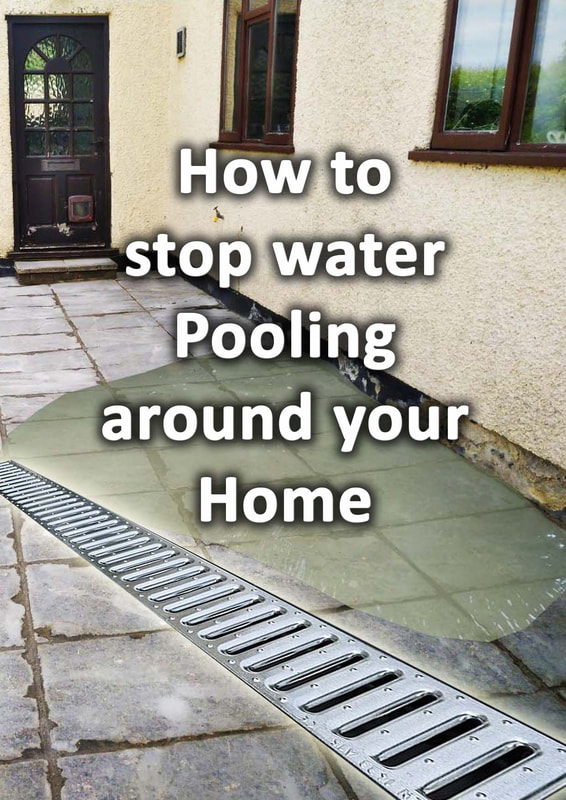|
This article contains affiliate links
Landscaping is very often overlooked in importance when it comes to developing a property. However, landscaping around your home to prevent water from congregating is an important commodity.
Water sitting around your home can lead to a multitude of problems which can become costly to repair. Boggy gardens and damp soils can also dramatically reduce the desirability of your garden and home overall. Long gone are the days of simply pluming access storm water into the drainage network. Drainage policy now requires any excess surface runoff from your property to be accommodated on site. Therefore landscaping around your home to prevent water run-off is of upmost importance. In this article I summarise the whole topic of landscape drainage around your property. I explain how to identify and diagnose drainage problems and how to solve them. Why is water sitting around my house?
The two most common reasons for water sitting around the home are surface levels and saturated ground. When it rains if water is travelling towards your home it means surrounding levels are directing water towards your property. This can be altered by re-working the levels and falls of adjacent lawns, borders and paving. If your garden has existing drainage problems it will have saturated ground. This ultimately means the water in your garden has nowhere to escape to in times of heavy rainfall. Such circumstances can be solved by installing drainage which we will explain later in the article. Other typical reasons for water sitting around your house include: Clogged gutters
Over a series of years roof gutters can become clogged with moss, leaves and other debris. Over time this can build up leading to clogged pipes. When it rains the gutters become overwhelmed pouring water down your walls and onto surrounding surfaces. This can be resolved by clearing out your gutters fully.
Blocked drainage channels
Drainage channels come in a range of different drainage features and products. The most common of these include grated channels which collect storm water run-off from paving. Like gutters drainage channels can easily become silted and blocked over time. If water is sitting around these drainage features give them a thorough clean out. Once debris is removed they can be flushed out with warm water.
Ruptured pipes
Although rare, ruptured pipes can lead to standing water around the home. Ruptured water mains will be obvious as there will be a continuous and vigorous flow of water. However most water mains run under the front of buildings and are very robust. Ruptured pipes are almost always fractured terracotta pipes which were a part of an old drainage system. The tell tale signs of these are random boggy areas or standing water isolated in a single location.
High water table
A water table is the level under the ground where water naturally sits seasonally. If you were to dig a deep hole in your garden the level at which water sits is your water table. The level of this depends upon your local weather, geology and topography. If you live within a river basin this will be higher and in more elevated areas much lower. A high water table means you may experience standing water in times of very heavy rain. Your local flood risk assessment should offer you specific information on this.
Sinking ground
Sinking ground is generally quite rare, however, there are a few reasons why it can happen. Recent excavations such as service trenches can result in subtle sinking as the ground naturally re-compacts. Incorrectly laid paving can also sink if the correct sub-base is not installed. Such slumping and low spots can help water to congregate and stand around your home. This can be solved by re-grading levels around your property, more on this later.
Nearby construction
Nearby construction of any kind can change the landscape drainage dynamics around your home. On a basic level any increase in local surface run-off can lead to standing water around your property. Surrounding properties only have so much garden space dedicated to lawn and flower borders to absorb excess water. Consequently, new patios, driveways, garden offices, conservatories and extensions all contribute to excess water run-off. Even if such surfaces come with drainage soak-aways the water is still being directed into the ground. This leads to excess soil saturation.
Dangers of standing water around your home
Flooding
Flooding where water actually breaches the entrances to homes is extremely rare and is mainly restricted to extreme regional flooding events. However very saturated sites at the lower end of slopes are at risk of localised flash flooding events. Even slight flooding can breach air bricks leading to damp foundations, and floor joists. Consequently, standing water around the home should be mitigated before freak weather events exacerbate the problem.
Damp
Standing water around your home increases the risk of splash back and rising damp. Even though most buildings have damp proof courses saturated ground can still be a problem. Dampness around foundations can lead to high humidity making joists and floor boards damp
Subsidence
In extreme cases too much water around the home can lead to movement within the surrounding ground. This can particularly be the case in regions of certain geologies and elevations. Water can lubricate small particles within the subsoil increasing the risk of movement and subsidence.
Freeze and thaw action
Freeze and thaw action is when moisture within masonry materials freezes and expands. The expansion of freezing water molecules leads to the fracturing and weakening of masonry structures. The result is a flaking and cracking to brickwork and porous concrete work. Consequently, making sure your homes masonry work is dry during the winter months is of upmost importance.
Bacteria
Moisture and water sitting for a period for time provides the perfect breeding ground for bacteria. This is especially so during the summer months when germs breed at a faster rate. This can lead to the risk of infectious disease to your household and local animal life.
Odours
Saturated surfaces are challenging to clean making them susceptible to bacterial growth and bad odours. These are especially off putting around lawns and garden seating areas.
Mold
Mold is a dust like growth formed by certain types of air borne fungi. These mold fungi thrive in damp conditions and particularly upon paper, card, clothing and timber products. Water around the home can increase humidity levels leading to the risk of mold establishment. Mold can cause bad smells as well as an allergic reaction especially in people with Asthma.
Pests
Excess water around your home encourages the establishment of microscopic plants such as algae. Over time this leads to a base of other microscopic creatures and ecosystems. Such environments eventually encourage larger pest species such as insects, invertebrates and vermin. The less water you have around your home the less chance there is of encourage unwanted guests.
The problem with modern storm water legislation
There is no doubt that sustainable drainage legislation attempts to solve flash flooding and the pollution of waterways. However, there are many unintended consequences of implementing such rules. Current legislation requires all water runoff from new development or hard surfacing to be retained on site. Overtime this can dramatically increase the amount of ground water around urban areas.
Particularly during heavy rainfall the natural ability for soil to absorb water becomes compromised. This leads to boggy soil and flooded gardens.
Eventually this leads to unusable backyards and in extreme cases can cause ground movement and subsidence. Directing water into soak-aways and french drains works for so long until these installations become overwhelmed. The best solution to resolve the problem would to be to create expansive wetland parks outside towns and cities.
These wetlands would be designed to accept and clean urban runoff using native wetland plants. The storm water could be completely contained from existing waterways whilst providing recreational parks and habitats for wildlife.
One of the biggest barriers to this becoming reality is space and cost. Real estate around urban areas is some of the most expensive and difficult to develop. How to diagnose your drainage problem
Boggy lawns and flower borders
Boggy lawns and borders are a sign of ground saturation. Saturation occurs when your existing backyard cannot naturally absorb the amount of water running to it.
If this is a recent problem it may be the case that your locality is experiencing greater volumes of surface runoff. This could be due to heavier rain fall, recent building work or a change in levels to surrounding or adjacent properties. Standing water on paved surfaces
If you have standing water sitting on paved surfaces it is clear the water has nowhere to escape. It could be a patio drainage system has failed or a grated channel drain has become blocked. If your paved surfaces have puddles it is possible the levels are not allowing water to fall away. This could mean you need to relay some areas or install a drainage system.
Isolated puddles of water
If your garden has developed a spontaneous puddle of water in one area it could be a broken or leaky pipe. Very often isolated puddles in lawns and flower beds are a result of broken pipes. The most common reason is old broken clay or concrete land drainage pipes. In such cases you should carefully excavate around them to expose the source.
|
The Author
|
Landscaping services across Buckinghamshire, Amersham, Aylesbury & High Wycombe
Hyde Heath, Amersham, Buckinghamshire |
|































